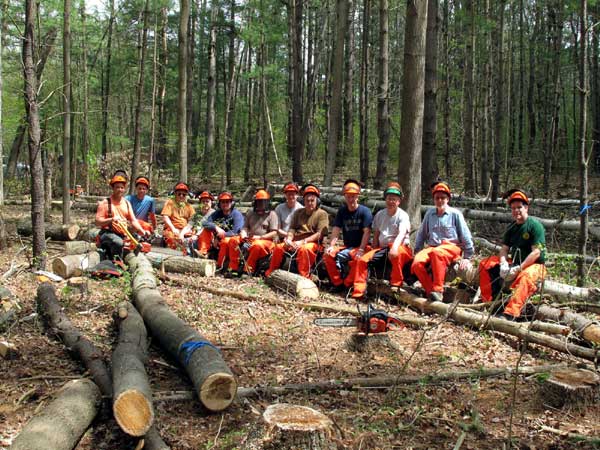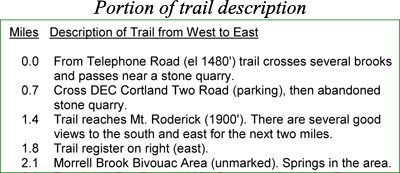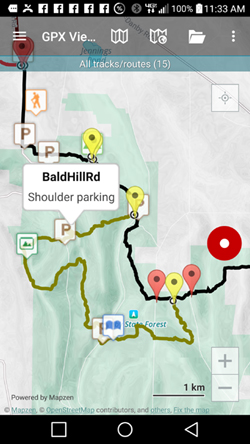by Margaret and Ken Reek
Image yourself in the following setting: brilliant sunshine, a crystal clear blue sky, no wind, no noise except for a few birds, and in the company of a few good friends. Sound good so far? Now drop the thermostat down to about 20 degrees, add a fresh dusting of fluffy white snow on top of a solid base, and you have a perfect winter day! This column will be a slight twist from our usual in that we’ll talk about a special season on the FLT – winter.
Winter on the FLT
Many folks choose to hibernate in winter and miss out on great opportunities to enjoy the outdoors in a quiet and beautiful time of year. They also miss out on a great way to get aerobic exercise in an environment where it is easier to control your body heat. We’d like to suggest that you rent a pair of snowshoes and head out to your favorite section of trail for a new view on the familiar. Here are some reasons why:
In winter you have a much better idea of what animals are active in the area because they leave tracks in the snow. We’ve seen many areas where there are so many tracks it looks like the turkeys must have been having a convention! The deer also like “hiking” the trail – be careful not to get suckered into following their tracks rather than the blazes. It’s fun to see a little hole in the snow and then notice the trail of tiny mouse tracks leading to or from it. Squirrel tracks jump from the base of one tree to a neighboring tree. Snowshoe hares leave their dot-dot dash-dash tracks to remind us they are there. At other times of year we are less aware of the other creatures that share our surroundings because these signs are not visible.
Proper clothing makes all the difference between an enjoyable experience and a horrific one. Snowshoeing is the best aerobic activity we’ve ever encountered, more than even cross-county skiing. As with any aerobic activity you generate lots of heat, so proper layering of clothing is essential for a successful hike. You’ll want a daypack big enough hold all the layers you’ll shed as you generate heat. A wicking base layer, such as Cool-max, next to your skin is essential for moisture management. Wear a wool or polar fleece shirt on top of that, and finish off with a shell for wind and/or moisture protection. We like wearing convertible mittens that allow you to flip off the top, so your hands can vent easily. A headband is good for keeping your ears warm while allowing your head to dissipate heat. You can use your summer hiking pants, maybe with a light pair of long johns; rain pants may be needed if your snowshoes kick snow up your backside like Margaret’s do. Leg gaiters will keep the snow from falling into your boots; get the breathable kind or you’ll end up with wet legs. Wear waterproof hiking boots to ensure dry feet; unless it is bitter cold you can use your regular boots.
As you start to generate heat (read sweat), start shucking off layers into your pack. When you stop for a break, throw on a layer to keep from getting chilled. You may need to do some experimentation to find what weight layers work best for you in the different conditions that winter can offer. Never wear cotton! It absorbs the moisture and holds it next to your body, which will make you cold. It also takes forever to dry.
When we finished the FLT on snowshoes last January first, we each were wearing a short sleeve shirt, light-weight nylon pants, knee-high gaiters and fleece arm gaiters – no jacket, hat, gloves or other usual winter layers. We didn’t start the day that way, but after we got going that was all we needed or wanted to stay comfortable. The minute we finished, on went the fleece, hat and gloves that show in our pictures.
Winter can be a wonderful time of year to enjoy the outdoors, so ignore all the whining of the TV weathermen and get out into the winter wonderland this ours to discover. If you can walk, you can snowshoe. Think snow!
















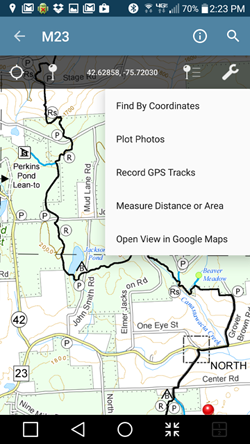


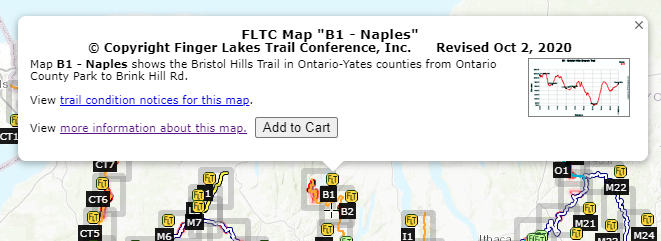


 This is an overview map of the Finger Lakes Trail System. It shows tracks of the main trail, branch trails, loops and spurs. The track colors represent the blaze colors for the branch trails, loops, spurs, and sections of the main FLT not blazed in white. Most of the main FLT is depicted in black & white for better visibility on various map backgrounds, but blazed in white on the ground. Trail closures (hunting, logging, etc.) and recommended bypass routes are depicted as shown at right. Hover over a track to display the name and length. Tracks colored
This is an overview map of the Finger Lakes Trail System. It shows tracks of the main trail, branch trails, loops and spurs. The track colors represent the blaze colors for the branch trails, loops, spurs, and sections of the main FLT not blazed in white. Most of the main FLT is depicted in black & white for better visibility on various map backgrounds, but blazed in white on the ground. Trail closures (hunting, logging, etc.) and recommended bypass routes are depicted as shown at right. Hover over a track to display the name and length. Tracks colored 
 This is a overview map of the Finger Lakes Trail System. It shows tracks of the main trail, branch trails, loops and spurs. The track colors represent the blaze colors for the branch trails, loops, spurs, and sections of the main FLT not blazed in white. Most of the main FLT is depicted in black & white for better visibility on various map backgrounds, but blazed in white on the ground. Trail closures (hunting, logging, etc.) and recommended bypass routes are depicted as shown at right. Hover over a track to display the name and length. Tracks colored
This is a overview map of the Finger Lakes Trail System. It shows tracks of the main trail, branch trails, loops and spurs. The track colors represent the blaze colors for the branch trails, loops, spurs, and sections of the main FLT not blazed in white. Most of the main FLT is depicted in black & white for better visibility on various map backgrounds, but blazed in white on the ground. Trail closures (hunting, logging, etc.) and recommended bypass routes are depicted as shown at right. Hover over a track to display the name and length. Tracks colored 
